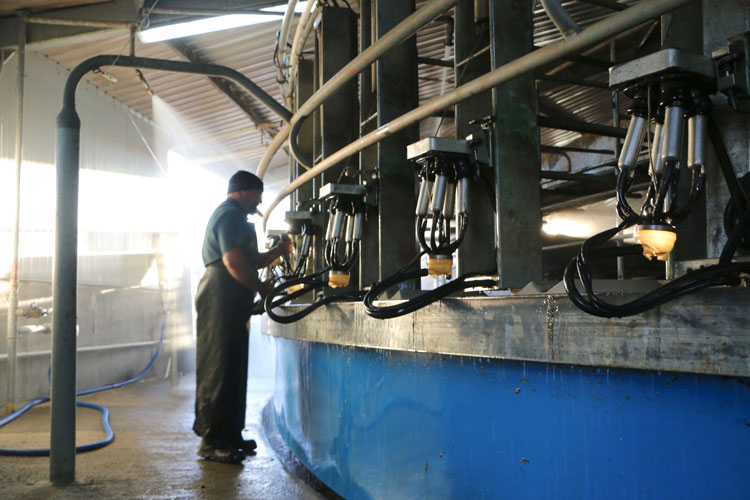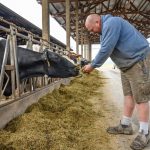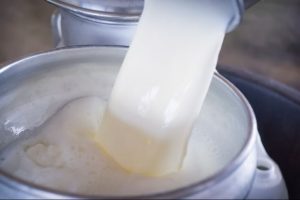
Output in the top 24 producing states amounted to 17.8 billion, up 1.6%. The April total included dumped milk.
Revisions added 115 million pounds to the original March total, now put at 19.375 billion pounds, up 2.8% from March 2019 instead of the originally reported 2.2% increase.
April cow numbers totaled 9.38 million head in the 50 states, down 4,000 from March but 49,000 above a year ago. Output per cow averaged 1,993 pounds, up 18 pounds from a year ago or 0.5%.
California output was up 0.3% from a year ago. Cow numbers were down 4,000 but output per cow was up 10 pounds. Revisions added 61 million pounds to the Golden State’s March count.
Wisconsin’s April output was unchanged on 9,000 fewer cows but output per cow was up 15 pounds. Revisions added 13 million pounds to the Badger State’s March total.
Ticking down the list, Idaho was up 6.3%, thanks to 29,000 more cows than a year ago and 30 pounds more per cow. Michigan was up 1.6%, thanks to a 20-pound gain per cow and 3,000 more cows. Minnesota inched up 0.4% on a 20-pound gain per cow offsetting 3,000 fewer cows. New Mexico was down 0.3% on a 65-pound loss per cow, though cow numbers were up 9,000.
New York was up 1.5% on a 35-pound gain per cow offsetting 1,000 fewer cows. Oregon was up 1.9%, with 3,000 more cows offsetting a 10-pound drop per cow. Pennsylvania was up 1.6%, thanks to a 65-pound gain per cow making up for a loss of 10,000 cows.
Texas put 4.9% more milk in the tank than a year ago, easy to do with 28,000 more cows, although output per cow was unchanged. Washington state was up 1.2% on 2,000 more cows and a 10-pound gain per cow.
Culling rises
Dairy cow culling dipped in April but was up from a year ago, according to the USDA’s latest Livestock Slaughter report. An estimated 279,400 head were sent to slaughter under federal inspection, down 8,600 head or 3% from March but 10,900 head or 4.1% above April 2019. A total of 1.13 million head have been culled in the four-month period, down 16,300 head or 1.4% from 2019.
98 cents a gallon
The Agriculture Department announced the June Federal order Class I base milk price at a depressing $11.42 per hundredweight, down $1.53 from May, $5.65 below June 2019, and the lowest Class I price since September 2009. The price equates to only 98 cents per gallon, down from $1.47 a year ago.
The mid-year Class I average stands at $15.84, down from $15.94 at this time a year ago and compares to $14.47 in 2018.
Signup for help
Today, Tuesday, is the first day of farmer signup for the Coronavirus Food Assistance Program, the direct payments for producers funded by Congress and implemented by USDA. The National Milk Producers Federation is urging all dairy farmers to use the program, which will provide much-needed and much-appreciated aid in upcoming weeks and months. Contact your local USDA Farm Service Agency office to enroll.
Stocks bulging
America’s refrigerators are bulging. The Agriculture Department’s latest Cold Storage report shows April 30 butter stocks totaled 368.7 million pounds, up a whopping 59.1 million pounds or 19.1% from March and 77.9 million or 26.8% above those a year ago. Closed restaurants will do that.
American cheese jumped to 836.2 million pounds, up 59.8 million pounds or 7.7% from March and 53.5 million pounds or 6.8% above a year ago.
Stocks in the “other” cheese category hit 620.8 million pounds, up 45.9 million pounds or 8.0% from March and 33.8 million or 5.8% above a year ago.
The total cheese inventory stood at 1.483 billion pounds, up 10.8 million pounds or 7.9% from March, and 84.9 million pounds or 6.1% above April 2019, ending seven consecutive months that total cheese stocks were below the year before.
Butter slips
Cash block Cheddar entered the Memorial Day Weekend at $1.9375 per pound, up 15.75 cents on the week and 25.5 cents above that week a year ago.
The barrels finished at $1.89, 17 cents higher on the week and 31 cents above a year ago, with 4 cars of block sold last week at the CME and 49 of barrel.
The markets were closed Monday for Memorial Day but traders took the blocks up 2.5 cents Tuesday, hitting $1.9625, on 4 unfilled bids, highest since Jan. 24, and up 96.25 cents from its April 15 bottom of $1.00 per pound.
The barrels were up 2 cents Tuesday, to $1.91, with 4 cars exchanging hands.
A shortage of fresh cheese appears to be driving prices higher. HighGround Dairy, in its Tuesday Morning “Huddle,” credited the filling of short term orders for the foodservice pipeline as well as filling USDA Food Boxes and keeping up with solid export demand.
Cheese market tones are in a “bullish fervor,” says Dairy Market News, and some Midwest cheese producers are concerned about falling behind demand. Mozzarella-provolone producers in particular say their East Coast customer base has come back and pipelines are getting refilled. Milk availability has tightened and Midwestern cheese inventories are moving, when just weeks ago they were a “looming concern.”
Western cheese plants are running near capacity but are cautious. Market uncertainty is prompting a few processors to hold back but surges in food service demand and government purchases are clearing available stocks. Inventories are heavy but much of the supply is committed to purchases made at lower prices and set to ship in the next few months.
Butter climbed to $1.6425 last Thursday but closed Friday at $1.5925, down 5.25 cents on the week, ending three consecutive weeks of gain, and 79.5 cents below a year ago. There were 22 sales last week at the CME.
Tuesday’s butter lost 1.25 cents and slipped to $1.58.
Butter makers report cream is tightening noticeably. Foodservice demand is picking up and retail is steady but butter inventories are a concern for some, who question if they will fall behind orders for later in the year, particularly as cream availability has shifted. Some question its longevity but the current tone is bullish.
Western foodservice butter usage remains poor as only a few restaurants had reopened so far, and people are still cautious about dining out. Bulk butter sales are good but there is presently more interest in retail butter. Meanwhile, more and more cream is being rerouted to ice cream production, says DMN.
Nonfat dry milk hit $1.0150 per pound Thursday but closed Friday at $1.0125, 7.75 cents higher on the week but 3.25 cents below a year ago, with 28 sales.
The powder was up 1.25 cents Tuesday, climbing to $1.0250, highest since March 13.
CME dry whey lost 2.75 cents last week, closing Friday at 36.25 cents per pound, a quarter-cent higher than a year ago, with 13 sales for the week.
Tuesday’s whey lost 2.25 cents and slipped to 34 cents per pound, lowest since April 7.
























